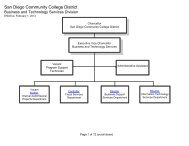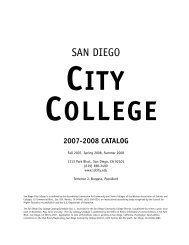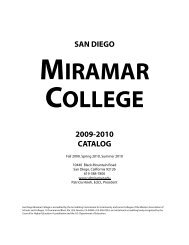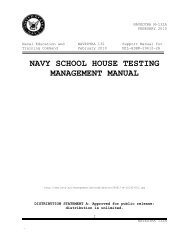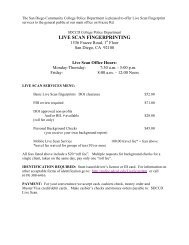NAVY SCHOOL MANAGEMENT MANUAL
NAVY SCHOOL MANAGEMENT MANUAL - AIM
NAVY SCHOOL MANAGEMENT MANUAL - AIM
- No tags were found...
Create successful ePaper yourself
Turn your PDF publications into a flip-book with our unique Google optimized e-Paper software.
careful analysis of all factors which may impact or be<br />
impacted by the change in the schedule. Some of these<br />
factors are under the control of the CO.<br />
Course factors which should be considered before deciding<br />
to implement 6 +2 include the following:<br />
<br />
<br />
<br />
<br />
<br />
To maximize the benefits of 6 +2, the 6-hour block of<br />
training should NOT be interrupted with long breaks<br />
such as meal breaks. Activities may elect to start<br />
the instruction early in the morning. This may cause<br />
a shift in the instructor's work hours. If management<br />
cannot accommodate this shift, compression may not be<br />
appropriate. Without this accommodation, the<br />
instructor's workday increases by several hours which<br />
causes increased instructor dissatisfaction and may<br />
impact the ability of the instructors to provide the<br />
student the level of assistance required.<br />
Courses undergoing a revision should not be considered<br />
for conversion to the 6 +2 schedule until after the<br />
revised course has been validated under the 8-hour<br />
schedule.<br />
Courses, which are less than 80 hours generally,<br />
should not be compressed. The reason a course is<br />
compressed is to provide the opportunity for remedial<br />
instruction. Courses less than 80 hours often do not<br />
have more than one examination occurring at or near<br />
the end of the course. These courses generally do not<br />
experience high drop from training, attrition, or<br />
setback rates.<br />
Courses with few numbers of non-graduates and low<br />
setback rates are not good candidates for 6 +2. It is<br />
the potential savings generated by reducing these<br />
rates which offset the cost of developing alternative<br />
learning options. Exceptions to this generally are<br />
courses where student populations have vast<br />
differences in experience or skill levels. In such a<br />
situation, the +2 period can be used to compensate for<br />
these differences.<br />
Contract instructors are teaching compressed courses<br />
where the work required is clearly delineated in the<br />
SOW. Converting courses to a compressed schedule<br />
after the contract has been awarded will require a<br />
modification to the contract and must be coordinated<br />
with the Contracting Officer's Representative (COR).<br />
Such changes may result in increased contracting<br />
costs, which must be approved prior to implementation.<br />
3-16<br />
NAVEDTRA 135C



